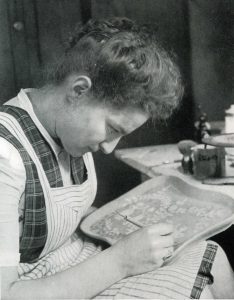
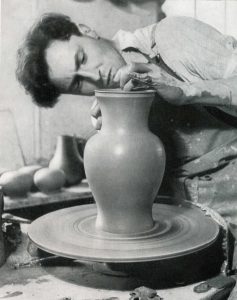
Erika Gerber and Jakob Stucki, 1946
Jakob Stucki and Erika Gerber-Stucki in CERAMICA CH
Andreas Heege, Andreas Kistler 2022
Much has been written about Jakob Stucki (see the list of references, especially Schneider 1979). While little remains to be added, it is nevertheless worthwhile to present the key facts about his artistic and ceramic work here and to compile an overview of the products from his workshop that are available. It must be borne in mind, however, that his wife Erika Gerber-Stucki was the second pillar of the business throughout several decades of their working together, although she almost never signed her pieces.
Jakob Stucki (1920–1982) was born on 7th August 1920. His father had a guesthouse in Konolfingen and Jakob was in line to take over the business. Upon leaving school, he attended a commercial college in La Neuveville and then completed a course in hotel management in Zurich and from there worked in various grand hotels in Graubünden, England and the Netherlands. It was in the Netherlands that he discovered his talent for drawing and began to attend courses. When the Second World War broke out, he was called up for military service and trained as an officer. Having completed active service, he joined the ceramic department at the School of Visual Arts and Design in Bern, as the thought of working in the hotel industry for the rest of his life held little attraction for him.
He received basic training in Bern and his instructors, Werner Burri (Schnyder 1985, 8-31) and Benno Geiger (Schnyder 1985, 32-51) would leave a lasting impression on him. He went on to study under Fritz Haussmann in Uster, and in 1944, he completed his training as a potter and pottery painter. In 1945 he joined the workshop of Adolf Gerber (1879-1951) at 3 Güterstrasse in Langnau.
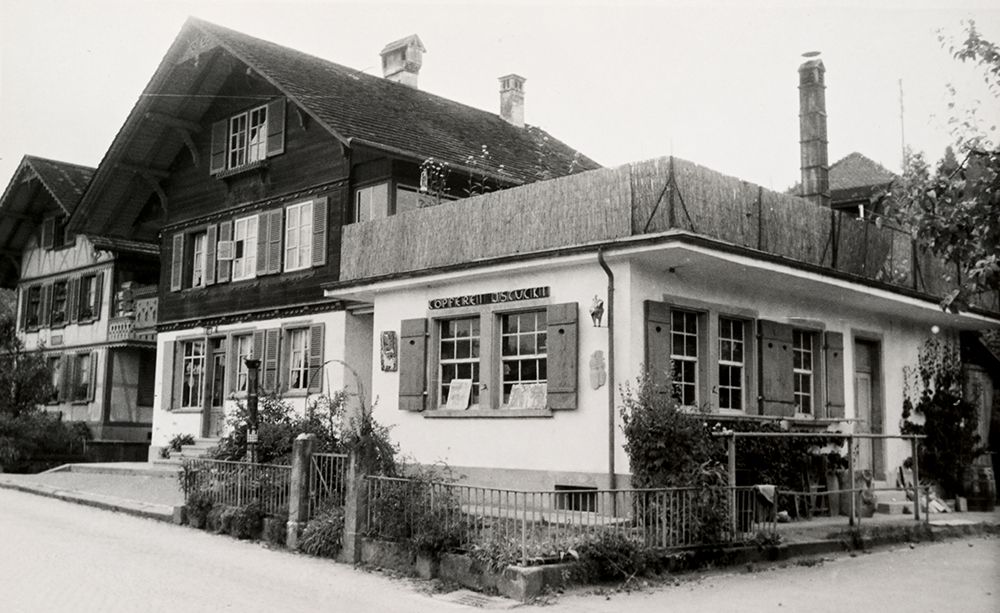
The potters’ property at 3 Güterstrasse in Langnau, after 1948.
This was where he met his future wife, the potter’s daughter Erika Gerber (1919–2004). The couple married in 1946. Erika Gerber was never given an opportunity to train as a professional ceramicist. She spent her formative years learning the craft in her father’s workshop and she later worked as a pottery paintress while overseeing the logistical and economic running of the business.
The year they got married saw the publication of an article in the journal Heimatwerk – Blätter für Volkskunst und Handwerk (Laur 1946) entitled “Junges Leben in der alten Langnauertöpferei” [New life in the old Langnau pottery], which is well worth reading. At the same time, Jakob Stucki himself wrote: “It is my desire to paint good-quality peasant pottery. The fact that I can do everything myself from throwing to painting, glazing and firing the vessels has awakened a great love in me for this beautiful craft, which I hope will never diminish.” (Stucki-Gerber 1946).
The photographs in the article, which would be just the beginning of a period of close collaboration with the Swiss Homeland Association (Heimatwerk), were taken by the photographer Hans Heiniger from Schüpfheim. The series of pictures recorded various important aspects of the workshop and production in 1946.
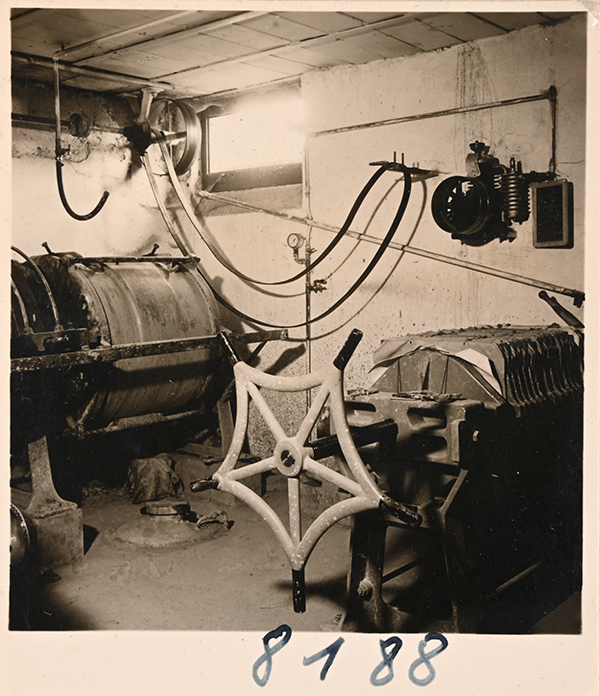
Glaze grinder, clay mill and filter press (preparation of clay and glazes), 1946.

Jakob Stucki working at the pugmill (to homogenise the clay and disperse any air bubbles), 1946.
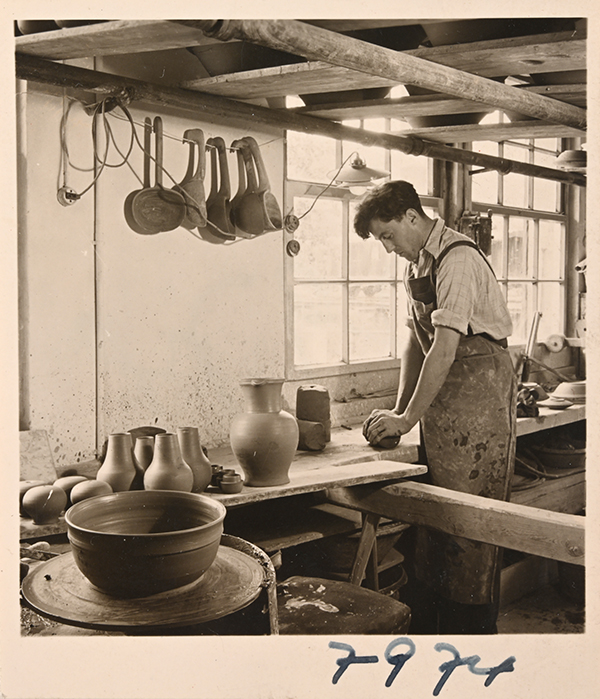
Jakob Stucki kneading the clay and cutting it into portions (preparation for throwing), 1946.
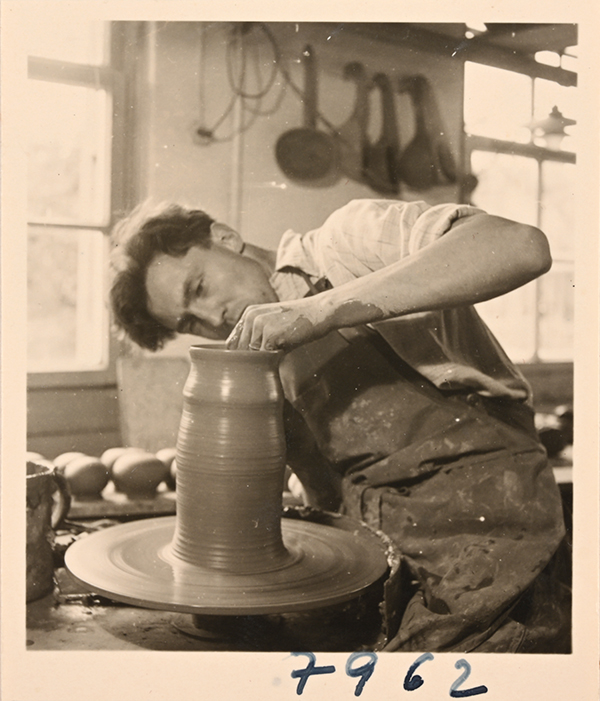
Jakob Stucki at the potter’s wheel, 1946.
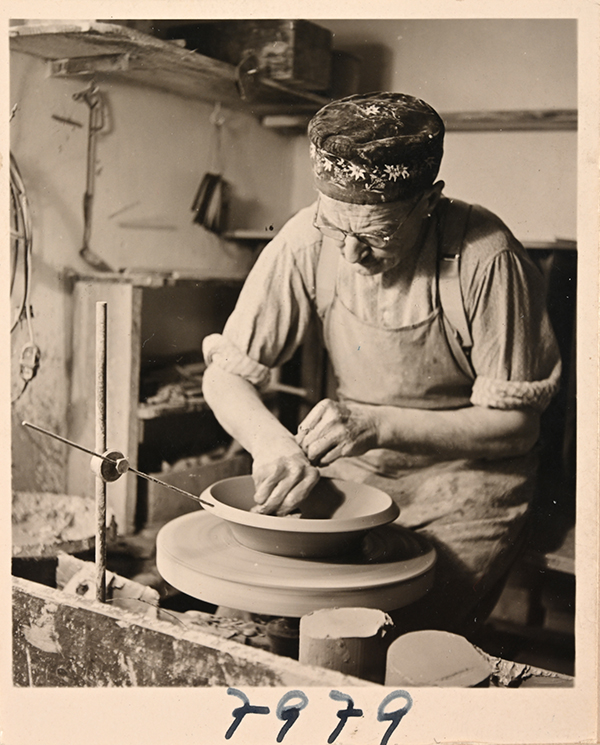
Jakob’s father-in-law, Adolf Gerber, at the wheel. A throwing gauge helps to ensure that the deep dishes with bevelled rims are all the same size, 1946.
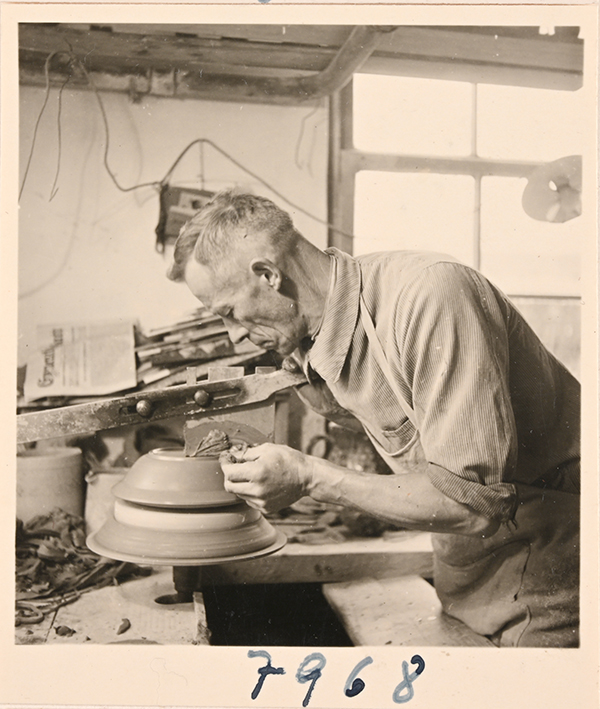
Thanks to a plaster mould (not visible, on the potter’s wheel) and a jigger, bowls and plates can very easily be made, even by non-skilled workers, 1946 (unidentified worker).
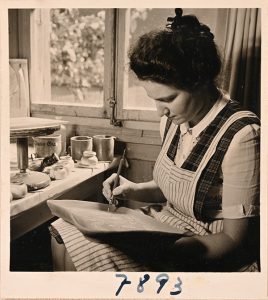


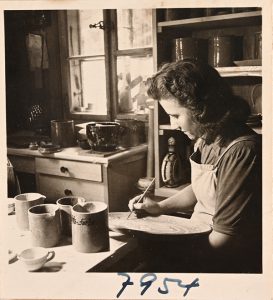
Besides Erika Gerber-Stucki and Jakob Stucki, several other painters and paintresses were employed at the workshop in 1946.
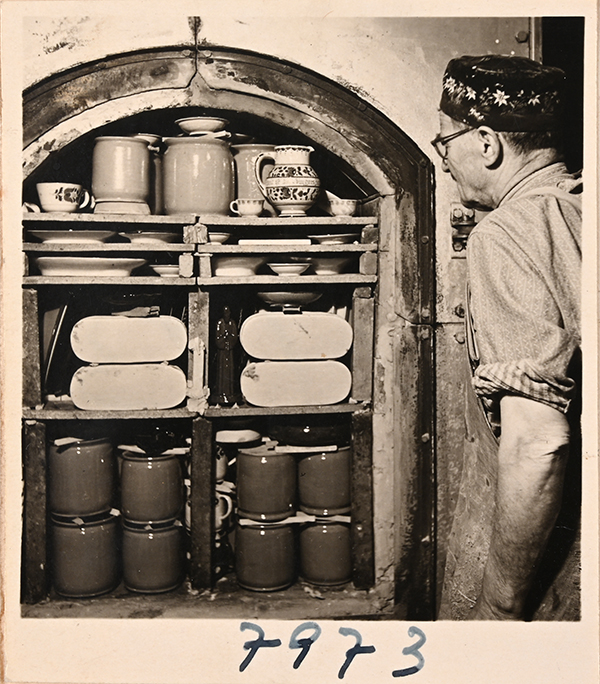
The contents of the electric kiln and the vessels on the drying boards show that ordinary everyday wares and storage vessels were still popular after the Second World War. In later years, it was Erika Gerber who loaded the kiln.

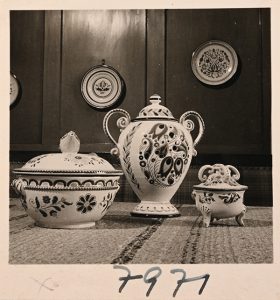
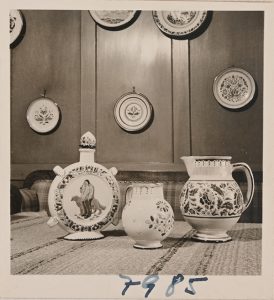

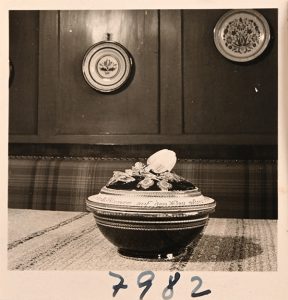
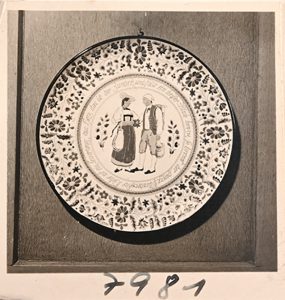
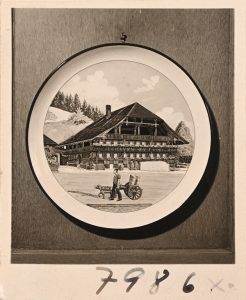
Pottery decorated in the Old Langnau style was very important, as were the plates with mottos and motifs designed by Paul Wyss and almost photorealistic views of farm houses, which were created by a German pottery painter (whose name, unfortunately, is not known) as individual orders.
It was probably during this period (c. 1946/1948) that Jakob Stucki made a series of figures on the theme of the Gerber workshop, which are now in the collection of the Langnau Regional Museum. They show all the important steps in the process, from preparing the clay to selling the finished products.
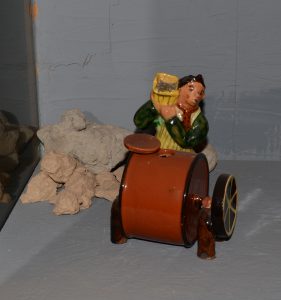
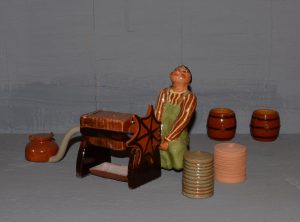
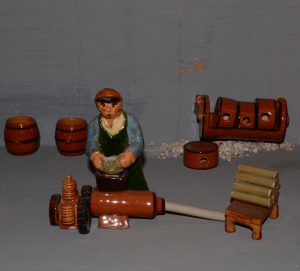
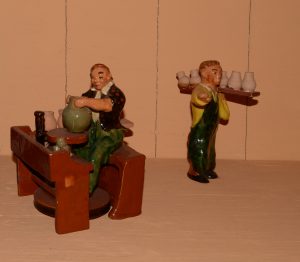
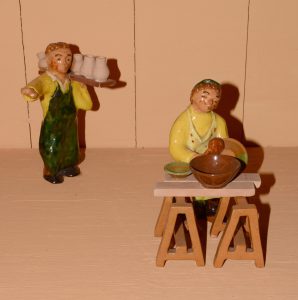
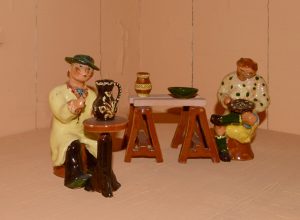
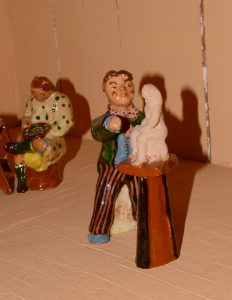
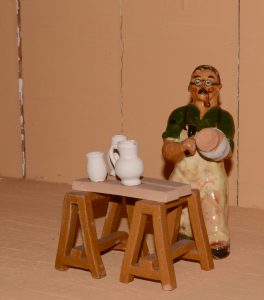
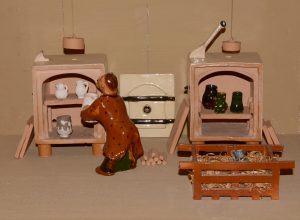
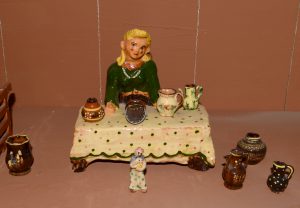
Apparently, working with his father-in-law did not come easy to Jakob Stucki at the beginning, as the two men found it hard to agree on the future direction of the workshop (Schneider 1979, 17).

Pottery from Jakob Stucki’s early period, c. 1948/1955.
With its slip-trailed decorations, incised to accentuate specific elements, and its dark background colours, Stucki’s early work was clearly influenced by Heimberg wares rather than the Langnau tradition.
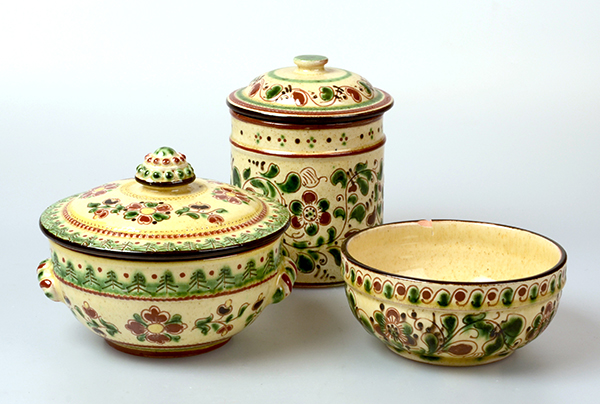
Pottery decorated in the “Old Langnau Style“, signed by Jakob Stucki, after 1948.
It was not until he took over the workshop himself in 1948 (SOGC 66, 1948, 1542, 29th May 1948) that he turned his attention back to the “Old Langnau” patterns, which the Stucki workshop and its team of pottery paintresses perfected. In the subsequent decades, the production of “Old Langnau” ware would always remain one of the mainstays of the workshop. Regular pottery sales through the Heimatwerk retail outlet in Zurich secured the economic viability of the enterprise. The longstanding working relationship between the two companies was even the topic of an anniversary exhibition in 1971.
In 1953, Stucki began to create sculptures, which were displayed at numerous exhibitions in Switzerland and abroad. Over time, this earned him a rather special reputation among modern-pottery enthusiasts. From 1955 onwards and between 1965 and 1973 in particular, he also made several large ceramic murals (e.g. for the Brügger company in Bern, the primary school buildings in Signau and Langnau, the church hall in Langnau, the Gurnigel Restaurant, the nursing home in Bärau, and several private commissions for various other places including London).
From 1955 to 1962, Stucki taught potting techniques at the vocational school in Thun.
Over time, his slip-trailed motifs began to lose the “romantic and sweet quality”, which had been typical of his 1950s work. Due to ill health (lead poisoning) in the mid-1960s, he was eventually forced to reduce the size of his workforce and develop a new range of glazes which were not lead-based (Schneider 1979, 22-23).
This was when his slip-painted decorations, which were based on drawings depicting Swiss customs, the Emmental valley and its people, became really quite unconventional and devoid of any quaintness. Stucki developed a unique, finely graded style of slip trailing, often reminiscent of pointillism and abstaining more and more from additional incising, which would become characteristic of his later work. He did not want his ceramics to be seen as “naïve modern folk art” but rather considered his works to be intentionally stylised compositional mediums for transferring peasant motifs and traditional scenes into the 20th century. In the second half of the 20th century, Jakob Stucki was one of the most influential ceramicists in the context of the Emmental valley, the Canton of Bern and the Swiss pottery scene in general.
Jakob Stucki’s workshop continued to produce crockery and art pottery until his death in 1982, after which his widow, Erika Stucki Gerber, with the assistance of a number of throwers (Toni Gerber, N.N. Vanappel and Bernhard Stämpfli) and pottery paintresses (Rosmarie Hausmann and others) continued to run it until the year 2000. For the next while, until around 2004, she rented it out to Bernhard Stämpfli who, however, did not quite manage to achieve the same success as Jakob Stucki. When Erika Stucki-Gerber died, the business was dissolved, and the contents of the workshop were sold to another crafts enterprise in Langnau.
Jakob Stucki – Erika Gerber – A personal portrait by Wolfgang Bickel
Gerber-Kohler-Stucki-Aebi family tree
Obituary in: Bulletin KFS 1982
Translation: Sandy Haemmerle
References:
Aeschlimann 1928
Emil Aeschlimann, Alt-Langnau-Töpferei. Ein Beitrag zur Volkskunde. Beilage: Die rumänische Königin im Ilfis-Schulhaus, 8. Mai 1924, Bern 1928.
Bickel 2021
Wolfgang Bickel, Über den Glanz der Alten Engoben. Jakob Stucki (1920-1982) und die engobierte Irdenware des Emmentals. Neue Keramik, Januar/Februar 2021, 43-45.
Blum 1974
Robert Blum, «Ich bin ein Töpfer und ich bleibe ein Töpfer», Begegnung in Langnau. Der Töpfer und Plastiker Jakob Stucki, in: TV Radio Zeitung, März 1974.
Blaettler/Schnyder 2014
Roland Blaettler/Rudolf Schnyder, CERAMICA CH II: Solothurn (Nationales Inventar der Keramik in den öffentlichen Sammlungen der Schweiz, 1500-1950), Sulgen 2014, 370.
Friedli 1972
Peter Friedli, Jakob Stucki, der Töpfer von Langnau i.E., in: Heimatwerk, Blätter für Volkskunst und Handwerk, 1972, Heft 2, 43–60.
Gerber 1985
Heinz Gerber, Die Langnauer Töpfereien. Ein kleiner Überblick, Langnau 1985.
Heege/Kistler 2017
Andreas Heege/Andreas Kistler, Keramik aus Langnau. Zur Geschichte der bedeutendsten Landhafnerei im Kanton Bern (Schriften des Bernischen Historischen Museums 13), Bern 2017.
Laur 1955
E. Laur, Neue Emmentaler Töpferwaren, in: Heimatwerk, Blätter für Volkskunst und Handwerk 20, 1955, 152–155.
Ryser 2004
Dorothée Ryser, Jakob Stucki, der Mensch, der Töpfer, der Künstler. Begleitbroschüre zur Ausstellung vom 26. August bis 5. September 2004 im Kirchgemeindehaus Langnau, Langnau 2004.
Schneider 1979
Alfred Schneider, Der Töpfer Jakob Stucki (Suchen und Sammeln 4), Bern 1979.
Schnyder 1985
Rudolf Schnyder, Vier Berner Keramiker. Werner Burri, Benno Geiger, Margrit Linck, Jakob Stucki, Bern 1985.
Stucki-Gerber 1946
Jakob Stucki-Gerber, Wie ich Töpfer wurde, in: Heimatwerk, Blätter für Volkskunst und Handwerk 11, 1946, Heft 4, 111–114.

